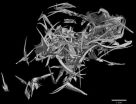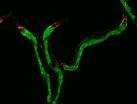(Press-News.org) JUPITER, FL, January 5, 2011 – A scientist from the Florida campus of The Scripps Research Institute has devised a new method of analyzing and quantifying changes in proteins that result from a common chemical process. The new findings could provide new insights into the effects of a highly destructive form of stress on proteins in various disease models, particularly cancer.
The study, published January 5, 2011, in the online Early View of the journal Angewandte Chemie, was designated by the journal as a "very important paper," a distinction bestowed on less than five percent of its publications.
"This new technique allows us to home in on which proteins are modified to a significant extent during periods of stress and how that changes during disease progression," said Kate Carroll, an associate professor in the Scripps Research Department of Chemistry who conducted the study with Young Ho Seo, a research fellow at The University of Michigan. "It gives us the chance to look more closely at targets for possible therapeutic intervention. From a practical standpoint, the technique is simple and will be accessible to biologists and chemists alike."
The new technique focuses on the process of cysteine S-hydroxylation, which plays a significant role in a number of events related to physiology in both health and disease, including the regulation of signaling proteins in various disease states.
The ability of the new technique to focus on signaling pathways, particularly in diseases such as cancer, is critical.
"Chronic disease states such as cancer can involve the modification of signaling proteins through S-hydroxylation, but other housekeeping proteins may also be targets," she said. "Key to distinguishing which of these proteins may be involved in pathogenesis is the ability to measure the amount of S-hydroxylation at specific sites within a protein. Now you'll be able to tell. This should help accelerate target identification in these disease-related signaling pathways and allow us to focus on proteins that are important to the process."
During periods of cellular stress, caused by factors such as exposure to UV radiation or many disease states, the level of highly reactive oxygen-containing molecules can increase, resulting in inappropriate modification of proteins and cell damage.
One oxidant, hydrogen peroxide, functions as a messenger that can activate cell proliferation through oxidation of cysteine residues in signaling proteins, producing sulfenic acid (i.e., S-hydroxylation); cysteine is an amino acid is synthesized in the body.
Extending the Gains of an Earlier Study
In a 2009 study, Carroll found that sulfenic acid served as an early warning biomarker of the reaction between hydrogen peroxide and cysteine. Carroll tagged the miniscule reaction target with a fluorescent dye antibody. With it, Carroll was able to read the levels of sulfenic acid levels in various cell lines, including breast cancer cells.
The new technique takes those findings several steps further by allowing scientists not only to quantify the modifications to various proteins, but also to monitor these changes at the level of individual cysteines within a single protein.
Carroll used a class of reagents called isotope-coded dimedone and iododimedone, which traps and tags sulfenic acids, allowing the cysteine sites and modified proteins to be easily identified. These probes, which are highly selective for sulfenic acid, allow the S-hydroxylation process to be monitored at the exact site of the modification.
The tagged proteins can be then be analyzed by mass spectrometry, a standard technology used to determine the precise make-up of proteins and other molecules.
"This technique should be widely accessible to the scientific community because it's so simple," Carroll said. "It should allow researchers to identify proteins with altered S-hydroxylation profiles whose function may lend insight into events in disease progression and have utility as potential markers for disease detection."
INFORMATION:
The study, "Quantification of Protein Sulfenic Acid Modifications Using Isotope-Coded Dimedone and Iododimedone (ICDID)," was funded by the Camile Henry Dreyfus Teacher Scholar Award and the American Heart Association Scientist Development Award. For more information on the paper, see http://onlinelibrary.wiley.com/doi/10.1002/anie.201007175/abstract
About The Scripps Research Institute
The Scripps Research Institute is one of the world's largest independent, non-profit biomedical research organizations, at the forefront of basic biomedical science that seeks to comprehend the most fundamental processes of life. Scripps Research is internationally recognized for its discoveries in immunology, molecular and cellular biology, chemistry, neurosciences, autoimmune, cardiovascular, and infectious diseases, and synthetic vaccine development. An institution that evolved from the Scripps Metabolic Clinic founded by philanthropist Ellen Browning Scripps in 1924, Scripps Research currently employs approximately 3,000 scientists, postdoctoral fellows, scientific and other technicians, doctoral degree graduate students, and administrative and technical support personnel. Headquartered in La Jolla, California, the institute also includes Scripps Florida, whose researchers focus on basic biomedical science, drug discovery, and technology development. Scripps Florida is located in Jupiter, Florida. For more information, see www.scripps.edu .
END
AURORA, Colo. (Jan. 5, 2011) – The number of women who die from complications of anesthesia during childbirth has plummeted 59 percent over the last two decades thanks to improved monitoring and better medical techniques, according to a recent study.
The report's lead researcher, Joy Hawkins, MD, professor of anesthesiology and director of Obstetric Anesthesia at the University of Colorado School of Medicine, said the risks have been dramatically reduced due to a greater focus on eliminating complications of general anesthesia.
Hawkins examined 12 years of anesthesia-related ...
Scientists have discovered direct evidence of the diet of one of the most important group of ammonites, distant relatives of squids, octopuses and cuttlefishes. The discovery may bring a new insight on why they became extinct 65.5 million years ago, at the end of the Cretaceous.
Ammonites are among the world's most well known fossils but until now, there has been no experimental evidence of their place in the food chain. Using synchrotron X-rays, a Franco-American team of scientists led by Isabelle Kruta has discovered exceptionally preserved mouth organs of ammonites, ...
Powerful synchrotron scans of Baculites fossils found on American Museum of Natural History expeditions to the Great Plains suggests that the extinct group of marine invertebrates to which they belong, the ammonites, had jaws and teeth adapted for eating small prey floating in the water. One ammonite also provided direct evidence of a planktonic diet because it died with its last meal in its mouth—tiny larval snails and crustacean bits. The detailed description of internal structure of ammonites, published by a Franco-American research team this week in Science, also provides ...
Nanotechnologists at The University of Texas at Dallas have invented a broadly deployable technology for producing weavable, knittable, sewable, and knottable yarns containing up to 95 weight percent of otherwise unspinnable guest powders and nanofibers. A minute amount of host carbon nanotube web, which can be lighter than air and stronger pound-per-pound than steel, confines guest particulates in the corridors of highly conducting scrolls without interfering with guest functionality for such applications as energy storage, energy conversion, and energy harvesting.
Using ...
If you want to be surrounded by females on the prowl, it pays to be cool, at least if you are a male butterfly.
In an unusual example of sex role reversals, females actively court males after being exposed to cool, dry temperatures as caterpillars, Yale University researchers report in the Jan. 7 issue of the journal Science. Raised in the moist and warmer season as larvae, males take up the traditional roles of suitor, displaying their wing designs to females who do the choosing.
"Behavior in these butterflies is changed by the temperatures experienced during development," ...
Most of the time cancer seems to creep up gradually over time; cells become premalignant, then increasingly abnormal before they become cancerous. But sometimes cancers seem to pop up as if out of nowhere. Now, researchers reporting in the January 7th issue of the journal Cell, a Cell Press publication, have new evidence to explain how that can happen. Based on the DNA sequences of multiple cancer samples of various types, they show that cancer can arise suddenly in the aftermath of one-off cellular crises involving tens to hundreds of genomic rearrangements.
"We think ...
Using a new technology that relies on thousands of synthetic molecules to fish for disease-specific antibodies, researchers have developed a potential method for detecting Alzheimer's disease with a simple blood test. The same methodology might lead to blood tests for many important diseases, according to the report in the January 7th issue of the journal Cell, a Cell Press publication.
"If this works in Alzheimer's disease, it suggests it is a pretty general platform that may work for a lot of different diseases," said Thomas Kodadek of The Scripps Research Institute. ...
Most primary care physicians (PCPs) and kidney specialists favor collaborative care for a patient with progressive chronic kidney disease (CKD), but their preferences on how and when to collaborate differ, according to a study appearing in an upcoming issue of the Clinical Journal of the American Society Nephrology (CJASN). PCPs and kidney specialists need to partner more effectively to optimize care for patients with CKD.
Prompt referral of patients to kidney specialists can slow CKD progression or help patients prepare for dialysis or kidney transplantation in a timely ...
BOULDER—One of the most enduring mysteries in solar physics is why the Sun's outer atmosphere, or corona, is millions of degrees hotter than its surface. Now scientists believe they have discovered a major source of hot gas that replenishes the corona: narrow jets of plasma, known as spicules, shooting up from just above the Sun's surface. The finding addresses a fundamental question in astrophysics: how energy moves from the Sun's interior to create its hot outer atmosphere.
"It's always been quite a puzzle to figure out why the Sun's atmosphere is hotter than its surface," ...
LA JOLLA, CA-In making your pro-longevity resolutions, like drinking more red wine and maintaining a vibrant social network, here's one you likely forgot: dialing down your mitochondria. It turns out that slowing the engines of these tiny cellular factories could extend your life-an observation relevant not only to aging research but to our understanding of how cells communicate with each another.
So report researchers at the Salk Institute for Biological Studies in the Jan. 7, 2011, issue of Cell. Howard Hughes Medical Institute investigator Andrew Dillin, Ph.D., and ...



